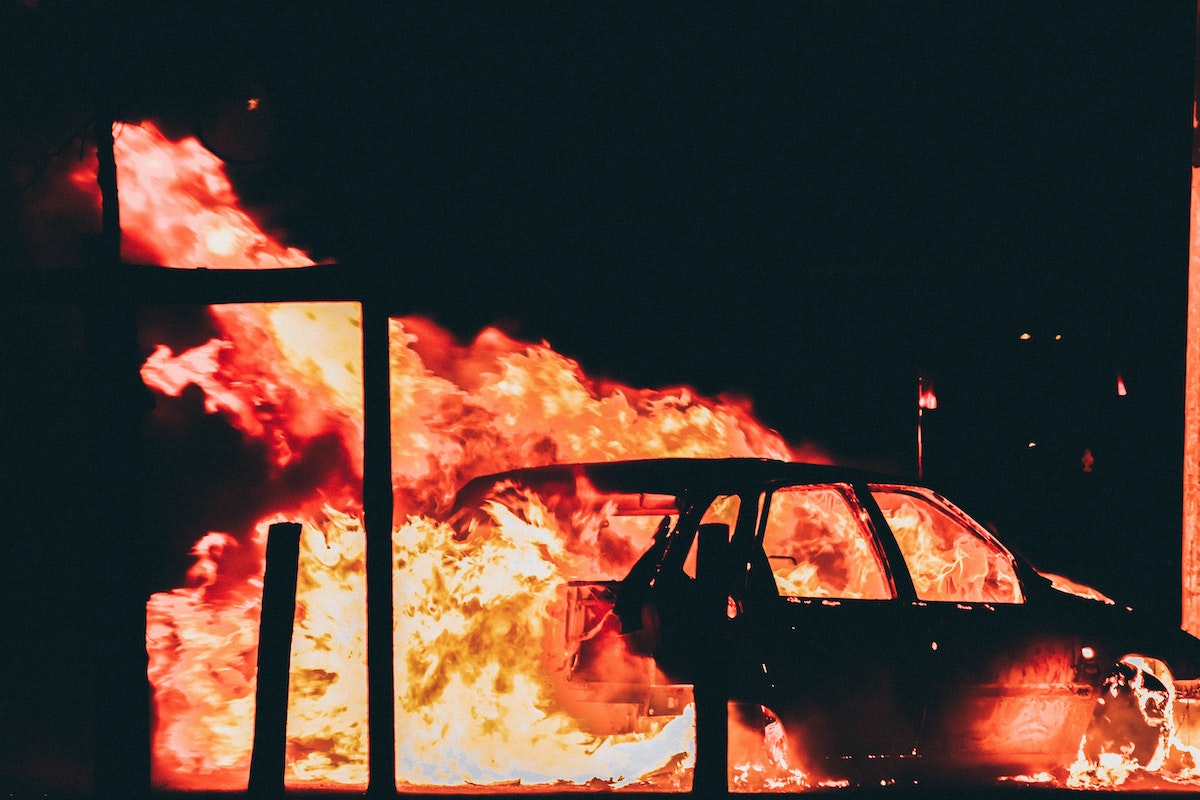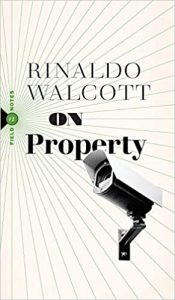BLM
Rinaldo Walcott’s On Property—A Review
Indeed, the title misleads: On Property focuses more on the historical threads linking the slave plantations to the abuses of modern policing than it does on its purported subject matter.

A review of On Property by Rinaldo Walcott. Biblioasis, 96 pages (May 25th, 2021)
The true founder of civil society was the first man who, having enclosed a piece of land, thought of saying, “This is mine,” and came across people simple enough to believe him. How many crimes, wars, murders and how much misery and horror the human race might have been spared if someone had pulled up the stakes or filled in the ditch, and cried out to his fellows: “Beware of listening to this charlatan. You are lost if you forget that the fruits of the earth belong to all and that the earth itself belongs to no one!”
Even if most sober-minded readers might dismiss Rousseau’s counter-factual history as a symptom of a dangerous utopianism, his critique of private property has fired the imaginations of radical thinkers and activists since before the French Revolution. While Rousseau himself did not believe we could return to a propertyless state as the “solution” to modernity’s problems, his view of history as a “fall” from natural goodness encouraged future Marxists to believe that the only way forward required a partial turning back. This logic is on display in Rinaldo Walcott’s short book, which has little to say about the history or nature of property, but much to say about the moral necessity of its abolition. Indeed, the title misleads: On Property focuses more on the historical threads linking the slave plantations to the abuses of modern policing than it does on its purported subject matter. So, despite the occasionally conspiratorial tone, it is perhaps a much more interesting book.

In fairness, Walcott acknowledges that his text is modelled on the abolitionist pamphlets from the 19th century, and it reads more like a cri de coeur than a stuffy academic treatise. Almost all of the secondary sources, for instance, are available online. And, in a way, this all works. There is a fugue-like quality to the writing, as we return again and again to the key themes (slavery, racism, police abuse), but explored through different historical lenses and contemporary illustrations. At times, this can be dizzying, as Walcott shuttles back and forth from George Floyd to the Haitian revolution, from the Rodney King riots to the G20 protests in Toronto, from Caribbean resorts to the role of prisons in California’s economy, from Rastafarianism to Hollywood hashtaggery (#oscarssowhite), all the while peppering the reader with statistics highlighting the racial inequalities between blacks and whites, particularly within what he calls “the criminal punishment system.” While a less generous assessment of Walcott’s style might involve comparisons with Glenn Beck’s chalkboard, there is a propulsive energy to the narrative, even if the organization is scattershot.
Walcott’s basic thesis is that the project of abolition is incomplete. Even if plantation slavery was abolished long ago, “the plantation persists as a largely unseen superstructure shaping modern, everyday life and many of its practices, attitudes and assumptions, even if some of those have been, over time, transformed.” The word “some” is doing a lot of work here, as Walcott focuses on those injustices and inequalities that still exist, while largely ignoring the material and moral progress all the races have made during the last 150 years. For Walcott, however, because the “plantation logic” is inextricably bundled together with policing and property rights, the “unfinished business” of the abolition movement means that the entire package needs to go.
Walcott is upfront and clear about what he wants, and whatever the merits of his proposals, his honesty is refreshing. Since the death of George Floyd last spring, many nose-ringed activists with very important hair have called for “abolishing the police,” only to backtrack and explain that, of course, what they really meant was police reform. To his credit, Walcott eschews this mealy-mouthed rhetorical gamesmanship and argues unequivocally and without qualification for the complete abolition of the police.
So what is the connection between the plantation on the one hand and the police on the other? Walcott reasons that American policing emerged historically from the practices of the plantation slave-catchers—terrorizing black people—which were then exported to the southern colonies before going viral across the continent. In fact, “[t]he ghosts of these policies… still exist throughout North America today.” There is perhaps a sliver of truth in this just-so story, but it also misleads. The big, urban police departments like the NYPD explicitly modeled their force on English policing practices when they were established in the 19th century—largely to crack down on unruly and impoverished Irish immigrants. But even if there were stronger historical links between contemporary policing and the horrors of the slave plantation, it is not clear why this would matter. If we were to look back on the history of medicine or psychiatry, we would not have to go back far before encountering another horrific mishmash of associations and destructive practices. And yet, it wouldn’t follow that we should close the hospitals and fire the doctors in order to somehow purify ourselves from the contaminants of the past.
At no point, then, does Walcott actually address many of the reforms that have been suggested to reduce the number of people killed by the police. Breonna Taylor, for example, would still be alive if the practice of “dynamic entry” or “no-knock” raids were abolished, or at least reserved for exceptional circumstances. Going back decades, millions of people—a disproportionate number of whom are black—would not be languishing in prison or haunted by criminal records if legislators put an end to the so-called “war on drugs.” More resources could be given to social services and mental health care if (especially America’s) police forces were substantially “demilitarized.” Police would not be sent out on calls that would be better handled by counsellors or social workers if the 911 system were to be rethought. Corrupt or incompetent officers could be more easily fired if there were independent bodies to investigate abuse, and the power of police unions were curtailed. And so on.

But for Walcott, this is all just cosmetic. When he does address a specific policy, like “broken windows policing,” it is only to remark that this practice, along with three-strike laws, is “a foundation of the prison industrial complex.” While broken windows policing has arguably led to more harassment and certainly produced higher arrest rates, it has also plausibly contributed to a reduction in violent crime. In New York City, there were over 2,200 murders in 1990, while only 633 people were murdered in 1998. In 2018, New York recorded just 289 murders, a drop on the previous year’s record low of 292. That sort of good news is left unmentioned. And while not yet fully understood, the recent and alarming uptick in violent crime since George Floyd’s death may well be the result of the “Ferguson effect”—a retreat from precisely these more aggressive policing tactics.
Following Angela Davis, who is fondly quoted throughout, Walcott argues that prisons should likewise be abolished. He notes that black and indigenous Canadians are massively overrepresented in the prison population, but like Ibram X. Kendi, he just assumes that the statistical disparities he invokes require no further analysis in order to support the conclusion that systemic racism is the cause of such outcomes. Walcott never asks, for example, why some racialized communities are underrepresented in the prison population, while others are overrepresented. Could it be that rates of violence in immigrant communities reflect the rates of violence of the homeland, but these rates will tend toward the national average by the second or third generation? Might culture play a role? Apparently, these sorts of questions should not even be asked.
Walcott’s tentative answer to what would replace the “carceral state” involves what he calls “community-led and accountable transformative justice practices.” The idea here is that injured and injurious parties should be afforded the opportunity to sit down together and negotiate an appropriate punishment or remedy for the harm that was done, as an alternative to throwing the perpetrator in prison. The Indigenous Gladue Court is held up as another model for how the carceral state could be “unlearned.” Of course, there is considerable agreement from across the political spectrum that too many people wind up in prison, but it is difficult to see how these sorts of proposals might work for serious criminality or outside of smaller, more homogenous communities. Consider Jeffrey Dahmer sitting down with the families of his victims, and “reflecting upon” how his ingestion of “Black beings” (Walcott’s phrase) symbolically re-enacts the colonial violence of the trans-Atlantic slave trade. What could go wrong?
In a somewhat chilling passage, Walcott describes the “jouissance” he felt watching the fires burn during the 1992 Los Angeles riots that erupted after the police officers who beat Rodney King were acquitted. By the time the violence subsided, 63 people were dead, over 2,300 people were injured, and the city had suffered over a billion dollars in property damage, much of it in “Koreatown,” where businesses were torched and looted. Whether these facts ultimately mitigated Walcott’s “jouissance” is left unstated. He does, however, defend the practice of looting, arguing that its purpose “is not stealing, at least stealing as it is commonly understood,” and should instead be considered as “part of a Black legacy of resistance to subjugation.” While this might be hard for the immigrant business owner to appreciate after losing his stock, Walcott is right to point out that rioting can lead to change—in Toronto in 1992, street violence led to Stephen Lewis’s report outlining a series of reforms to address the city’s inequalities and race relations.
The biggest hole in the book, however, is its refusal to state what type of property is to be abolished, and what the institutional arrangements will look like in the aftermath. While Marx called for public ownership of the means of production, he certainly would have viewed his library or his beard clippers as private possessions. Walcott appears to go further. He claims that property—both private and public—is “foundational” to the beliefs, values, and practices that have produced “the racial terror that we are subjected to” since Columbus first arrived in the Americas. Walcott apparently identifies as a “small c” communist, but as these and other passages suggest, he thinks all property should be abolished. Does this mean I could put my name on the cover of On Property and publish it with a different publishing house? Presumably, Walcott and Biblioasis would be unimpressed. In the end, however, we are simply enjoined to “imagine” a world without property, where there would be nothing to police. But the paucity of detail offered to fill in this utopian scheme would make even John Lennon blush.






